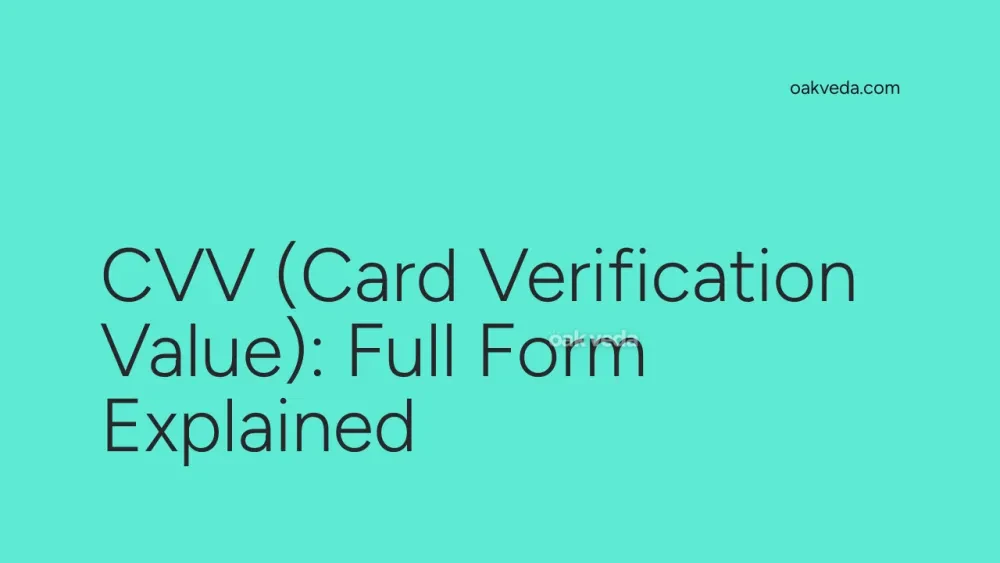
What is the Full Form of CVV?
The full form of CVV is Card Verification Value. This three-digit code plays a crucial role in enhancing the security of credit and debit card transactions, particularly in online and card-not-present scenarios.
What is Card Verification Value?
Card Verification Value, commonly known as CVV, is a security feature implemented by financial institutions on credit, debit, and ATM cards. It typically appears as a three-digit number printed on the back of the card, usually on the right side of the signature strip. For American Express (AMEX) cards, it's often a four-digit number located on the front of the card.
Origin and Development of Card Verification Value
The concept of CVV was introduced in the late 1990s as a response to the growing concerns about card fraud in the emerging e-commerce sector. Major card issuers like Visa, MasterCard, and American Express developed their own versions of this security code to add an extra layer of protection for cardholders.
How does Card Verification Value work?
The CVV works as an additional authentication factor during card transactions. When making an online purchase or placing a phone order, you're often required to provide this code along with your card number and expiration date. This process helps verify that you, the cardholder, have physical possession of the card, reducing the risk of fraudulent transactions.
Types of Card Verification Value
While the concept remains the same, different card issuers have their own terminology for CVV:
- CVV2: Used by Visa
- CVC2: Used by MasterCard
- CID: Used by American Express
Despite the different names, they all serve the same purpose of enhancing card security.
Functions of Card Verification Value
The primary functions of CVV include:
- Fraud prevention: By requiring this additional code, it becomes more difficult for fraudsters to use stolen card information.
- Authentication: It helps verify that the person making the transaction has physical access to the card.
- Enhancing online security: CVV is particularly useful in e-commerce and other card-not-present transactions.
Applications of Card Verification Value
CVV finds its applications in various scenarios:
- Online shopping: When making purchases on e-commerce websites.
- Phone orders: When placing orders over the phone.
- Manual entry transactions: In situations where the card can't be swiped or read electronically.
Features of Card Verification Value
Key features of CVV include:
- Unique to each card: The CVV is specific to each card and changes when a new card is issued.
- Not embossed: Unlike the card number, the CVV is printed, not embossed on the card.
- Not stored: Merchants are prohibited from storing CVV data after transaction authorization.
- Dynamic variants: Some issuers now offer dynamic CVV that changes periodically for enhanced security.
Benefits of Card Verification Value
The implementation of CVV offers several benefits:
- Reduced fraud: It significantly lowers the risk of unauthorized transactions.
- Increased consumer confidence: Knowing there's an extra layer of security encourages more online shopping.
- Cost-effective security: It's a simple yet effective method that doesn't require additional hardware.
- Universal acceptance: Most online merchants worldwide now support CVV verification.
Limitations or Challenges of Card Verification Value
Despite its benefits, CVV does have some limitations:
- Not foolproof: If a card is physically stolen, the CVV is visible to the thief.
- Can be phished: Fraudsters may try to obtain CVV through phishing attacks.
- Not used in all transactions: Some merchants may not require CVV, reducing its effectiveness.
Future Developments in Card Verification Value Technology
The future of CVV technology is evolving to address current limitations:
- Dynamic CVV: Some issuers are experimenting with CVV codes that change periodically.
- Biometric integration: Combining CVV with biometric authentication for enhanced security.
- AI-powered fraud detection: Using artificial intelligence to detect unusual patterns in CVV usage.
FAQs on CVV Full Form
-
Is CVV the same as PIN? No, CVV is different from PIN. While CVV is used for online transactions, PIN is used for in-person transactions at ATMs or point-of-sale terminals.
-
Can I share my CVV with others? No, you should never share your CVV with anyone, not even your bank. Legitimate businesses will never ask for your full CVV over the phone or via email.
-
What if I can't find my CVV? If you can't locate your CVV, contact your card issuer. They may provide it to you after verifying your identity.
-
Does CVV expire? The CVV doesn't expire, but it will change if you're issued a new card, even if your card number remains the same.
-
Can online merchants store my CVV? No, merchants are prohibited from storing CVV data after transaction authorization, as per PCI DSS (Payment Card Industry Data Security Standard) regulations.
In conclusion, the full form of CVV - Card Verification Value - represents a simple yet effective security measure in the world of card payments. As we continue to shift towards digital transactions, understanding and properly using CVV becomes increasingly important for both consumers and businesses in maintaining financial security.
You may be interested in:

